"Tenacity": Yet-Another-Sawppy-Project
Inspired by Roger and others, I'm making a SAWPPY-Alike rover, adding my own tweaks and mods.
Inspired by Roger and others, I'm making a SAWPPY-Alike rover, adding my own tweaks and mods.
To make the experience fit your profile, pick a username and tell us what interests you.
We found and based on your interests.
tenacity_woods.pngTenacity rolling through a local parkPortable Network Graphics (PNG) - 494.39 kB - 08/12/2021 at 05:26 |
|
|
I've been eyeing the botblox.io networking products for months but avoiding clicking on "Buy" because they were pricey but also came with a hefty shipping costs from the UK that made the on-my-desk costs almost 2X what the devices themselves costs. Which, I get and which is the world we live in now. So I've been looking and waiting and dreaming and waiting and continuing to struggle w/ USB and udev .
The good news is that there's a cheaper shipping option now and flush with a little extra Xmas cash, I did mash the "Checkout" button and this showed up on my desk at CircuitLaunch within a few days of ordering it last month.
. 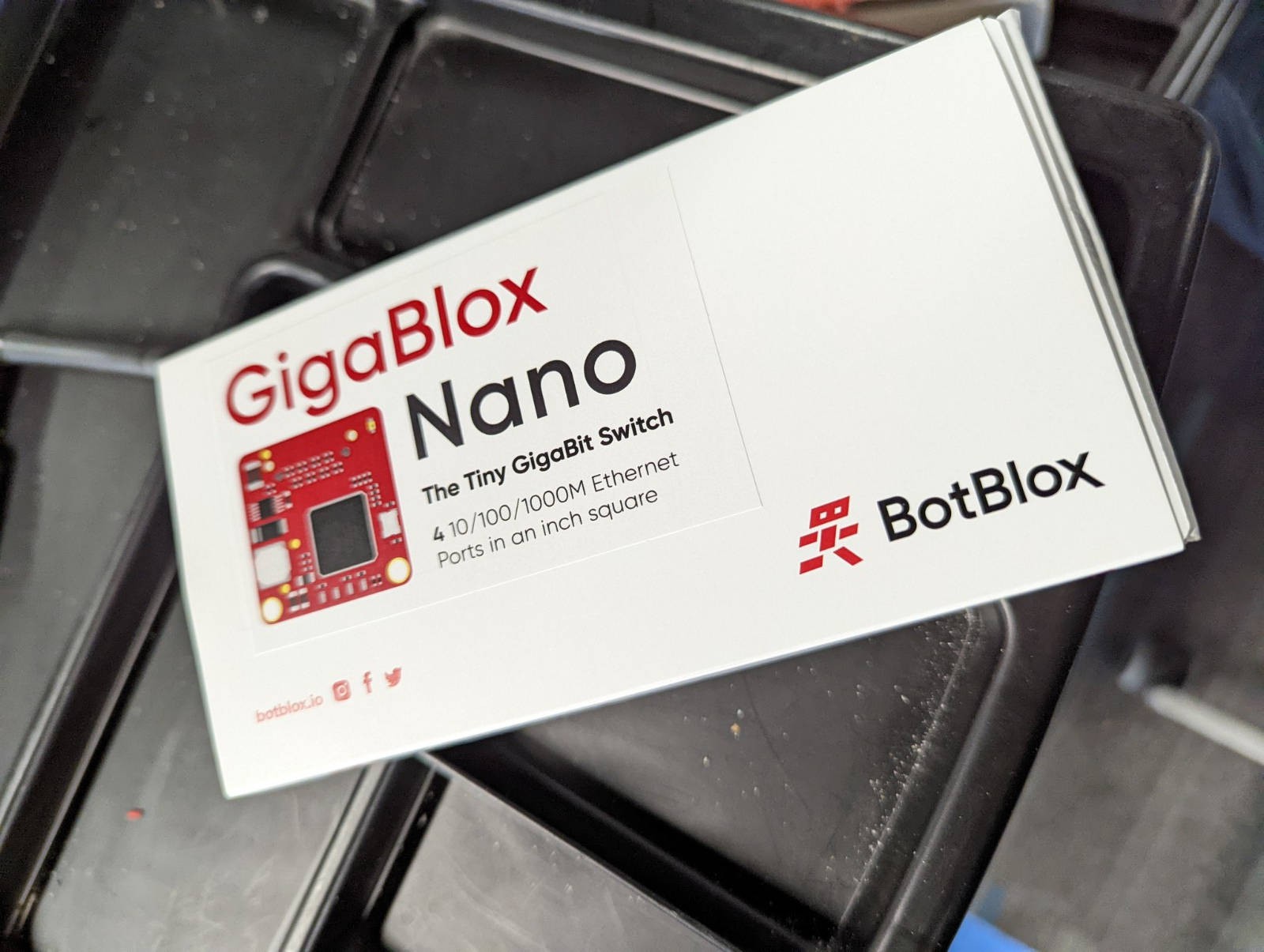
In case it hasn't sunk it yet, it's a tiny,tiny little gigabit network switch designed specifically for robots and drones. I'll let you go get all the specs off the Botblox site, but just look at it sitting on top of the TP-Link 5-port 100Mbit switch it's replacing. So tiny! So glowy! Botblox have been able to shrink a switch down to this size by engineering out most of the transformer/power management electronics that are in a typical switch. As a result, it's really meant to be installed in an isolated environment, like, say, a robot that needs its own internal LAN that doesn't really connect to the outside world.
So far it streams RGB & depth data off the OAK-D camera at 30FPS just fine and brings the entire networking stack up to 1 Gbit everywhere AND a 1A power savings. The electronics/compute bus is down to 2-2.5A draw now and that's low enough to dump the current honking 10A step-down that I got as a hand-me-down when I was first putting Tenacity together 3 years ago.
Slowly, bit-by-bit, early parts are getting swapped out for smaller, lighter, more capable, less power-hungry ones. The L298N motor controllers are gone, replaced with a VNH5019 from another robot a few months back. The tangle of Arduino Nanos, USB cables and udev rules are being replaced with Ethernet-capable Teensy boards( One of which, TBH, probably could run the entire rover, minus the cameras, if I felt like rewriting the entire control stack in custom C vs ROS) .
The tempo on major build work on Tenacity has definitely slowed over the past few months. At 2.5 years in, there's not a whole lot of major structural improvement to be done. I've been working on it steadily, but these are enhancements and improvements to things that have been bugging me over the long term.
Let's start with enclosures for the front and back ends. I created these over the holidays in December/January.
One thing that has been really useful is the addition of some "Debug Ports", so I don't have to go scrabbling around inside the main box to plug into the LAN or flash new code onto the Arduino, etc.
Shown here: Ethernet, USB and HDMI. 
The front here has slots for the cliff sensors, a pair of VL53L0Xs and slot for another camera or other sensor. Again, out with the sticky tape and zip-ties for actual sockets to mount things on :)
The real remaining work to be done at this point is software and I've been getting some work done on that too with the OAK-D depth-camera.
I've been lucky enough to be able to spend some time with the Boston Dynamics "Spot" quadruped robot and one thing I noticed right away was that it does obstacle avoidance even in teleop mode. On many robot platforms, "teleop mode" is a kind of dumb joystick control where the motors are being driven directly by joystick input. If the driver isn't paying attention or doesn't have sufficient skill, it's entirely possible to drive it into a wall or off the top of the stairs. Not "Spot". It deftly weaves and jogs around posts and ducts in the middle of the room, stops in front of doors and halts at the edge of stairs.
This seemed like pretty low-hanging fruit to add to Tenacity, so I made a weekend project out of making some sensor mounts, installing them and writing up some code for an Arduino to talk to them and publish the data as a ROS Range message. There are two HC-SR04 sonars, left and right, on the front wheel pods and a V53L0X in the center for a "cliff sensor".
I CAD-ed up a mount to fit on the brackets of the steering columns. They conform to the part and clip into the holes on either side. The part is mirrored for a left and right mount. I wanted something I could mount sonars or even a small camera like an ESP32-CAM to, so I left the attachment space purposefully flat and blank with the idea that they'd get mounted via double-sided tape or velcro.
A Python script subscribes to the ROS /ultrasonic topic(s) and publishes turn decisions to /cmd_vel to do the obstacle avoidance logic.
Here's a demo. I'm driving the rover forward here, deliberately aiming it at walls, shelves and other random obstacles. It's really doing quite well I think. I don't think I could cut some of these turns quite this close even if I tried. I'd love to hear your thoughts and comments.
I got these in the mail the other day:
Sawppy builders will recognize these as the triangular wheel hubs used to mount the wheels to the drive shafts of the motor pods. My buddy Ed "Steamboat" Haas and I have been collaborating on replacing the 3D-printed parts of the motor pods that have failed most often with metal equivalents. We're about a 2-hour drive from each other and the pandemic hasn't made collaboration any easier, but we've both got 3D-printers and tools and Internet connectivity and the hacker mindset to do crazy things and this the result. A bunch of hand-machined, hand-tapped triangular wheel hubs that started life as a single piece of round Aluminum stock.
I had to do a bit of filing and Dremel-ing to get them to fit inside the wheels, but that didn't take long. The Aluminum is soft, almost butter-like in comparison to the steel axles.
I also had to grind out the detents on the axles a bit deeper and make them lie a bit flatter because the metal hubs don't flex and deform at all, so any angles or nubs in the detents showed up in the new hubs tilting against the shaft which led to the wheels themselves visibly processing when driven.
For somebody like me who knows just enough about materials to be dangerous, this was a bit of an eye-opener. I knew there were divots and digs in the shaft detents, even if they appeared mostly flat, but the way the PETG conformed to these, even under the tension of the set screw biting into the shafts really masked these imperfections quite a bit. Even after this additional filing, the wheels still process a bit when free-wheeling, but this is mostly damped out with the rover on the ground and the wheels come under weight. On a couple initial test drives, this doesn't seem to affect the way the rover drives. I kind of don't care for now because this rover is still such an experiment and the metal hubs should go quite a ways to solving my problems of having to do wheel maintenance and swap out PETG hubs after a day's worth of driving.
Ed has his own album up over on Flickr documenting how these were made.
He also has a lot of neat stuff over on his Thingiverse account
I've been playing with this idea of an "airless" tire for Tenacity for a while now. I like Roger's original design WRT faithfulness to the actual style and dimensions of the Perseverance Rover wheels, but I think they're going to wear pretty quickly in the off-road conditions I hope to have Tenacity rolling around in.
I like the design of the wheel "knuckles", and don't want to completely redo all that, so as an intermediate step I was thinking last weekend about "Hey, maybe I could give it some slip-on treads...".
So, here you go: Procedural, parameterized slip-on "snow-tires" for your rover !
OpenSCAD script here:
https://www.thingiverse.com/thing:4582109
Pics below...I just really could not be happier at this point and have been posting this everywhere else on the Intercats, so this page should get the update too :)
The new metal bits I described in the previous post are installed. Set screws are biting hard against metal vs. sqooshing into nylon. It's like a whole new rover!
I've decided to plant a flag on some of the 3D-printed aspects of Tenacity, makes notes to myself(and here) and move on. I've got lots left to do and can't really do it when axles snap every 10-30 minutes. I've been working on Tenacity for a bit over a year now and have been through a bunch of iterations of the drive, steering and suspension components and am ready to move on.
So, the question is:
Can you, in 2020, 3D-print yourself a robot that weighs almost 20 lbs and have it support its own weight and move around ?
I'm going to answer that with a qualified "Yes". First, you're not going to do it just with PLA, or even just with PETG. You will need Nylon or some sort of Nylon-like blend for load-bearing parts and even then you're going to be replacing long, thin parts pretty often. But Tenacity did take its first rolls on all 3D-printed parts, except for the 1515 Aluminum body frame, center suspension rod and various nuts and bolts. I was able to set it down on the ground and the rocker-bogie shafts and the axles on the wheels and the corner steering all bore the weight of the rover.
So, where I'm going from here is moving back over to metal for the long, thin parts like the axles and shafts(about which in the next post) because as much as I've enjoyed being a total materials geek, I really need to get to where I can have Tenacity reliably rolling around and start testing some software, get the ROS stack firmed up, etc. I'm excited that I got as far as I did, and certainly just having the printed parts get me this far has really helped bring my version of SAWPPY to life.
| Material | Part | Result | Longevity | Notes |
| ABS | Steering & Drive shafts | Snapped off clean. | A few hours | These snapped when going over a hard bump. Sometimes along the retainer ring slot, but more often where the part was held by a set-screw. |
| Carbon Fiber-Nylon blend(NylonX) | Rocker & Bogie shafts, steering shafts, | Deflected, but held up the weight of the whole rover. Broke under shocks/stress. | Static:Indefinite Rolling/Operational: 10-30 minutes | These snapped at the retainer-ring slots as the rover entered a turn at speed and the weight/stress shifted to one side. Nylon, even with carbon-fiber stiffening, really wants to be part of an object with some "bulk" and not a long, thin part. |
| Carbon Fiber-Nylon blend(NylonX) | Drive & Steering Shafts, motor couplers, wheel hubs. | Steering shafts: Last longer than the rocker/bogie ones, but still eventually snapped. Motor shafts/axles: Rarely broke, deflected a bit. | Steering : Hours to days. Motor/Drive axles: Indefinite | The motor/drive axles are the real success story here. They are short enough to cross some sort of mechanical stress and volume threshold, even when the rover was going along at a good clip and swerving into turns, with the steering servos twitching left and right. I think I replaced maybe one or two of them and on analysis, found them to not have been printed at 100% infill. The solid ones didn't break. The couplers and wheel hubs were also pretty indestructable and are still in place. Again, chunky, substantial parts vs. long, thin ones. |
| Polycarbonate (PC) | Drive & Steering shafts, motor couplers, Wheel hubs. | Split or shattered within minutes, sometimes even when a set-screw was being tightened.... |
One important thing for a rover, esp. one that is capable of moving beyond line-of-sight is management/tracking of power. I've known I wanted some sort of networked, data-reporting battery and power management system. I feel like I have the software side of things down pretty well and electronics is sort of where I come up short. Fortunately, digging around on the Intercats for "Open Source battery monitor" or "ROS Battery monitor" or something similar, led me to this ROS-aware Battery Voltage Monitor.
The circuit itself is a big network of voltage dividers, which even I know how to put together, so not too horrible to put together over a weekend.
and the final realization installed on Tenacity, complete with readings off an 11.1V 5000 mAh LiPO battery shown as a ROS topic.
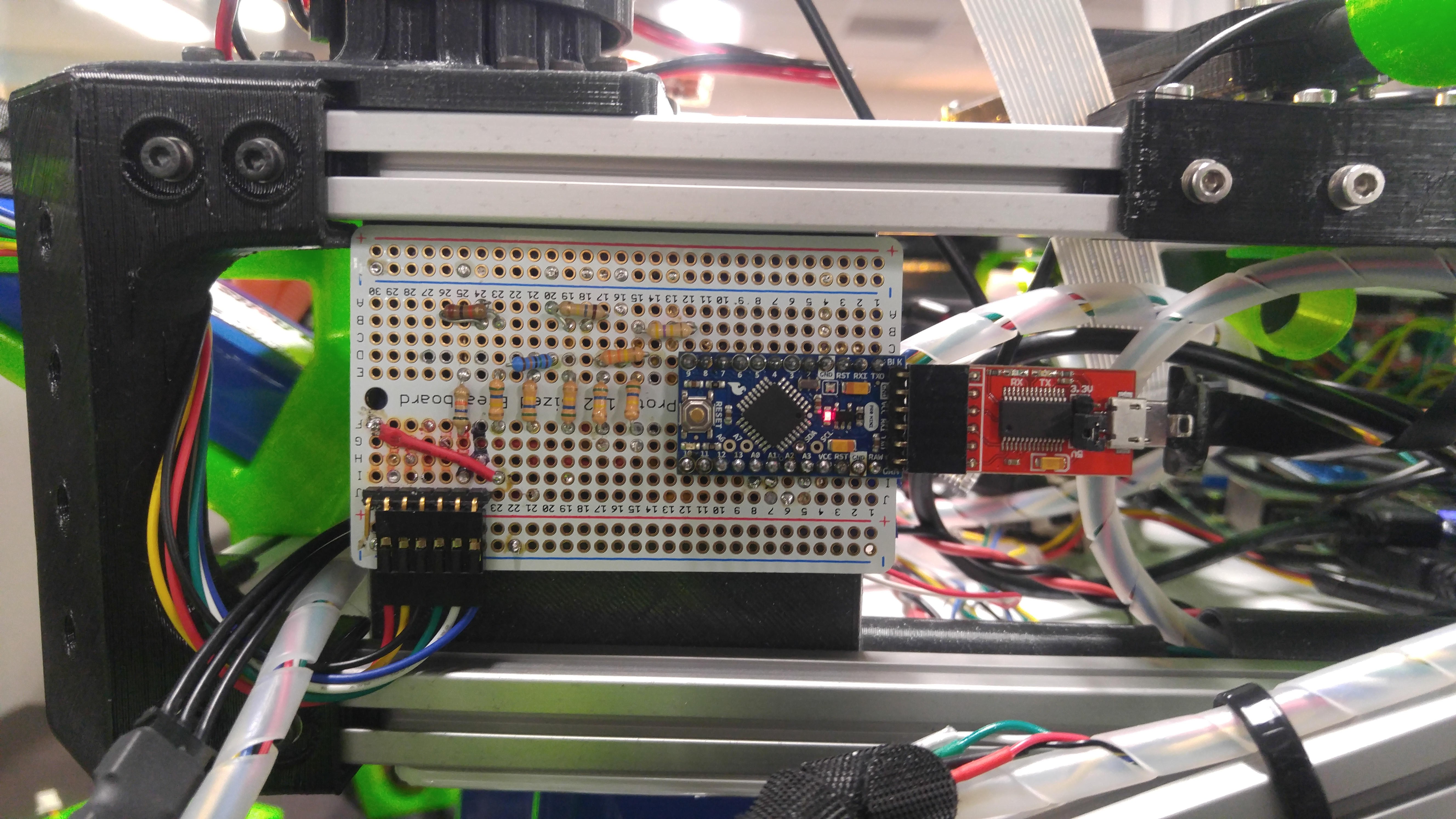
Here's some screenshots of some of the CAD I've been working on over the past month or two, while stuck inside because global viral pandemic.
Let's walk through a couple things in this image so you can get an idea of some of my plots and plans for when I can get back to working on Tenacity.
First we have these "sensor stalks". The one with the flat top is what's currently mounted on the rover. I'm playing with different angles on the top to incline a camera or LIDAR and give it a better view of the obstacles in front of it vs. seeing things at knee height and missing things underfoot. The one off to the left in the back is inclined 15 degrees. The one in the front is tilted 10 degrees.
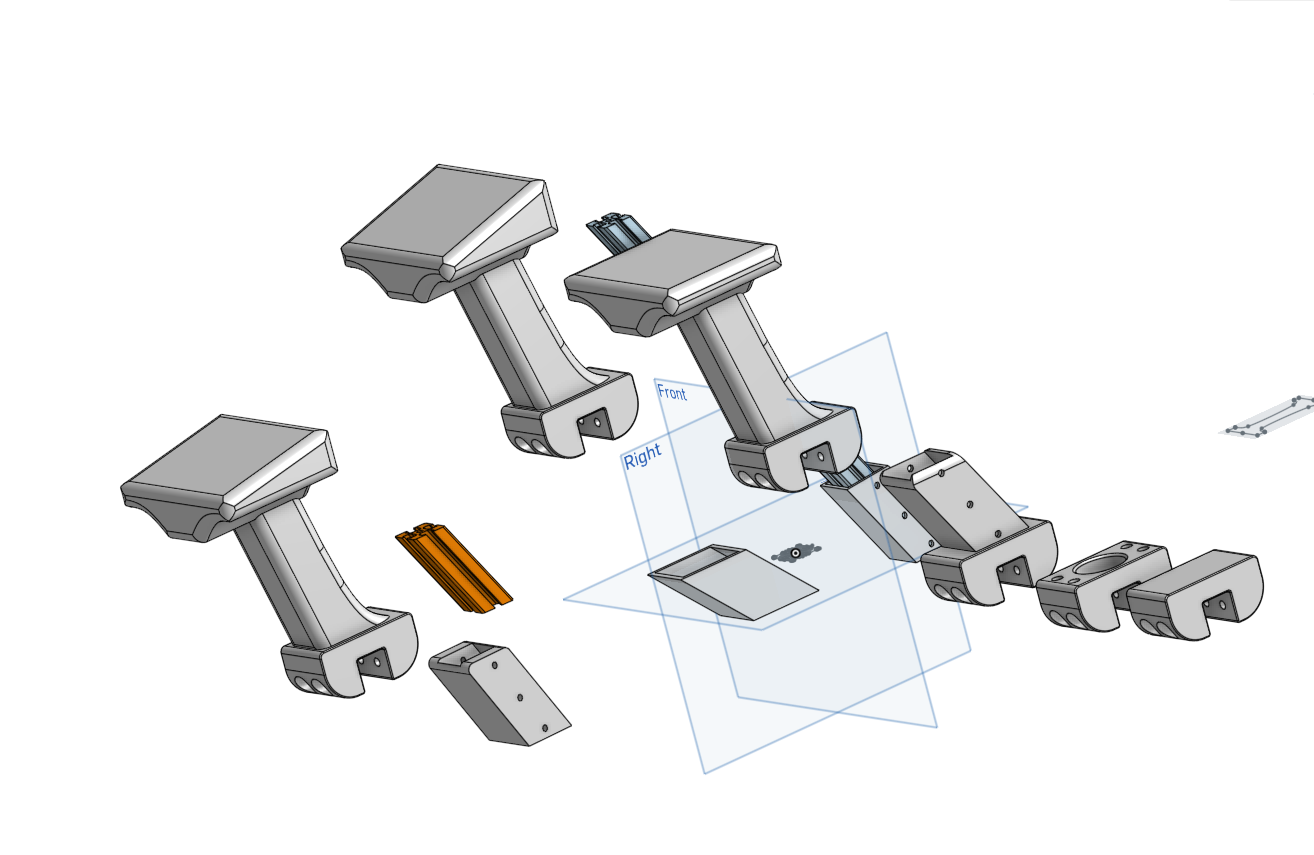
As much as I've tried to keep the cable plant under control with twisting and flex-wrapping the cable bundles, velcro-ing and routing them along the corners, it's becoming obvious that I'm going to need to add an additional "equipment deck" above the top of the body box. The original impetus behind this was to have a place to mount a Jetson TX1, but the more I worked out what the compute and vision-processing system would look like, the more I realized I just plain needed more space.
So here's a quick sketch of what that might look, modeled in a mix of OnShape and OpenSCAD.
The bracket is slotted for a length of 1515 to be inserted to support the weight of the additional hardware mounted up top.
Finally, we come to this bracket here, which has been showing up in most of the images here and should be recognizable by most Sawppy Builders as the bottom part of the differential holder. When I was building my Sawppy last summer, I became rather captivated and inspired by this particular piece. I really liked how it fit into the upper part of the differential and how it clamped onto the crossbar. So I "repaired" the holes in Onshape to make it a universal mounting bracket.
I'll upload these to my GitHub fork of Roger's Sawppy repo in case anybody finds them useful.
Tenacity is back on the road!(carpet), fresh from what turned out to be an almost 3 month(-ish) refit.
A good bit of consulting work came barrelling out of nowhere right after the start of the New Year, so I've spent most of the past couple months taking care of the funding that makes this rover roll. "No bucks, no Buck Rogers" as a man once said.
One thing that kept breaking last fall was the keypad that was part of the chording keypad teleop control. Replacing that meant getting serious about a proper control system, which led to a complete rewiring and internal reconfig, but overall a much more complete rover and much closer to an actual completed first rev platform.
Current config is:
Materials
Most of the NylonX parts have snapped at this point. The suspension for the rocker/bogie assembly have been replaced with metal. The surviving parts are all the shorter or thicker bits like the motor couplers and drive shafts. The last of the steering shafts broke last weekend when Tenacity got rear-ended by a runaway DonkeyCar. This has provided me with an excuse to open a spool of polycarbonate (PC) and print off some replacement parts. We'll see how these fare compared to the nylon. I will do a longer post about the whole 3D-printed structural adventure and all the different materials I've tried at some point in the future.
TBD:
-Get working on vision and navigation now that I have a driveable rover.
-Add power management support via an INA219 so I can get some sort of software visibility into the overall power consumption of the whole system and from there individual components.
-Sonar and maybe some bump sensors "for better hallway vision".
Anyway, that's an off-the-top-of-my head update on what's going on with Tenacity. Post below if you have comments or questions.
Create an account to leave a comment. Already have an account? Log In.
Hi Jake,
Thanks for the nudge. I pushed up the latest revisions of my code to my GitHub account. You can check it out here:
https://github.com/jetdillo/Sawppy_Rover/tree/master/modifications/jetdillo/code
I hope it helps you out.
I love seeing these Sawppy projects come to life, they're such an interesting rover design and a great illustration of 3D printing augmenting stock items (rather than outright replacing them). Thanks for drilling down to the details too!
It's a differential for keeping the whole robot level when it roves over a big rock(or backpack!).
There's actually a really good explainer here(In LEGO, which makes it even better :) ):
http://alicesastroinfo.com/2012/07/mars-rover-rocker-bogie-differential/
HTH!
What's the diamond-shaped assembly on the top middle of the chassis? It sort of looks like a gimbals, but for what? Checked out Roger's project, didn't see an obvious answer.
Looks like it's a pivot between the rocker arms on the left and the right. There's a central hub screwed to the extrusion, and then the diamond gives the barstock rigidity?
Become a member to follow this project and never miss any updates
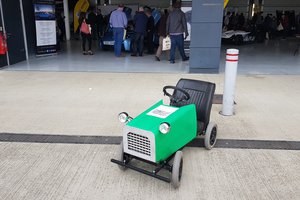
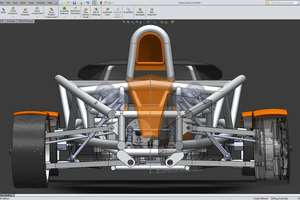
 kevinj
kevinj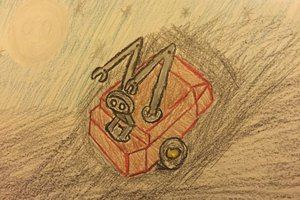
 Rudolph
Rudolph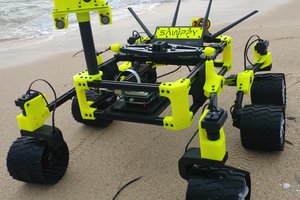
 TeamSG
TeamSG
Hi steve would you be able to provide access to the Software code so I can impliment the DC motors for my project?